| Srl | Item |
| 1 |
ID:
138114


|
|
|
|
|
| Summary/Abstract |
India is at the cusp of important financial sector regulatory reform. The reform aims at deeper changes in financial sector laws and regulatory architecture. While many incremental reforms were undertaken in the last two decades, the pace of change has slowed down owing to the constraints posed by the underlying legal framework.
|
|
|
|
|
|
|
|
|
|
|
|
|
|
|
|
| 2 |
ID:
138116


|
|
|
|
|
| Summary/Abstract |
India’s real Gross Domestic Product (GDP) growth averaged almost 9 percent per annum during the 5-year period 2003–04 to 2007–08. But since then growth has slipped substantially, reflecting both domestic and global factors. Real GDP growth fell to 6.7 percent in 2008–09 under the impact of the North Atlantic financial crisis (NAFC), but quickly rebounded to an average of 7.7 percent during 2009–12 benefitting from the unprecedented large and coordinated fiscal and monetary stimulus. However, subsequently (2012–14), annual growth averaged under 5 percent. Softer global demand, volatility in international financial markets on the back of the NAFC, higher domestic inflation, and governance issues have been among the main factors that led to the investment and growth deceleration.
|
|
|
|
|
|
|
|
|
|
|
|
|
|
|
|
| 3 |
ID:
138117
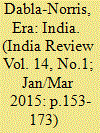

|
|
|
|
|
| Summary/Abstract |
India experienced unprecedented growth during the past two decades against the backdrop of wide-ranging “first generation” of reforms, growing trade and financial integration, buoyant external demand, and ample global liquidity. Like other emerging markets (EMs), India also enjoyed a good measure of macroeconomic resilience, evidenced by the fact that the Indian economy rebounded from the global financial crisis much sooner and faster than advanced and indeed, many other emerging market economies.
|
|
|
|
|
|
|
|
|
|
|
|
|
|
|
|
| 4 |
ID:
138109


|
|
|
|
|
| Summary/Abstract |
Over the past quarter century, the Indian economy has been transformed. Economic growth accelerated beginning in the mid-1980s to over 8 percent per year in the late 2000s after averaging only 3–4 percent per annum in the early decades of India’s independence. And, as a further sign of the new strength and resilience of the economy, India appeared to manage the shock of the global financial crisis with assuredness: maintaining a 7 percent growth rate in the face of a severe recession in the United States and Europe, and growth again accelerated to nearly 9 percent in 2009–10. However, more recently the situation has deteriorated. Growth has slowed to an average near 5 percent, a pattern that is expected to hold for the near future. There has been a substantial deterioration of many of the main economic indicators; the current account and fiscal deficits have widened, and inflation has remained at an elevated level. With a slowing of observed rates of domestic saving and investment, concerns have also arisen that India’s potential growth rate may have fallen. Finally, given the large twin deficits, fears have been expressed about the possible emergence of some external vulnerability. These developments were accompanied by growing voter dissatisfaction and the election of 2014 brought in a new government.
|
|
|
|
|
|
|
|
|
|
|
|
|
|
|
|
| 5 |
ID:
138115
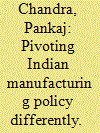

|
|
|
|
|
| Summary/Abstract |
The policy debate on manufacturing in India often gets confounded by a poor articulation of its objectives and by a weak rationale for its industrial structure. The 2013 Economic Survey of India put its finger neatly on one of the objectives and a key issue at stake here—the extent and quality of employment1—though the UPA2 government could not implement its own manufacturing policy during its tenure. That a robust manufacturing helps build deep technological capabilities in our society, thereby making the nation strategically strong, escapes much of our policy thinking. Whether the NDA3 government’s “Make in India” plan will change the face of India (a potential that exists) or will it just remain a slogan of intent will depend, to a large extent, on our understanding of the second aspect of the policy confusion in manufacturing—why do we do, what we do and how we do it—the rationale behind the our industrial structure and the resulting competitiveness or lack of it.
|
|
|
|
|
|
|
|
|
|
|
|
|
|
|
|
| 6 |
ID:
138112
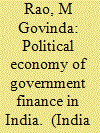

|
|
|
|
|
| Summary/Abstract |
This article deals with important developments in Indian public finance. The main focus of the article is the use of government finance as an instrument for development and the political economy issues inhibiting its efficient deployment. In particular, the recent political economy developments have posed serious difficulties in calibrating sustainable fiscal policy and have raised questions about the effectiveness of anchoring public finance policies for accelerating growth, reducing poverty and promoting human development.
|
|
|
|
|
|
|
|
|
|
|
|
|
|
|
|
| 7 |
ID:
138113
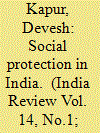

|
|
|
|
|
| Summary/Abstract |
Since the late 1990s, the Indian state has both expanded the ambit of social and economic rights for its citizens as well as launched major programmatic initiatives. Cumulatively these measures (weak as they may be) have woven safety nets for social protection and provide rudimentary underpinnings of a welfare state.
|
|
|
|
|
|
|
|
|
|
|
|
|
|
|
|
| 8 |
ID:
138110
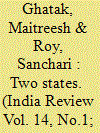

|
|
|
|
|
| Summary/Abstract |
The recently concluded Indian parliamentary election—where more than half a billion voters queued up in nearly a million polling booths over 6 weeks—was fought largely on the plank of development. The newly elected Prime Minister, Narendra Modi of the Bharatiya Janata Party (BJP), won a decisive majority and his party ran its campaign largely revolving around his personality, and his track record as the Chief Minister of the prosperous state of Gujarat since 2001. Exploiting well the widespread discontent over economic slowdown, inflation and corruption scandals of the previous government under the United Progressive Alliance (UPA), the BJP managed to set the terms of the debate by touting the model of development pursued by Modi in Gujarat as a prototype for the remainder of India.
|
|
|
|
|
|
|
|
|
|
|
|
|
|
|
|
| 9 |
ID:
138111
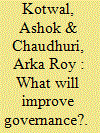

|
|
|
|
|
| Summary/Abstract |
The parliamentary elections of May 2014 saw an electoral rout of the ruling coalition (United Progressive Alliance or UPA) and especially that of the main partner “Congress” (Indian National Congress or INC). The party that ruled India for most of its post-Independence period was decimated while the party that had little electoral presence at the time of Independence now has an absolute majority. The Modi-led-BJP made “governance” a key issue that played a major role in their victory. With an absolute majority in the parliament, the BJP has an unprecedented opportunity to fulfill the mandate and improve the quality of governance. Will they? What would it take to improve governance in a country like India? The goal of this paper is to try and answer this question.
|
|
|
|
|
|
|
|
|
|
|
|
|
|
|
|